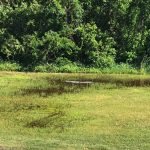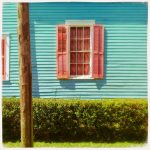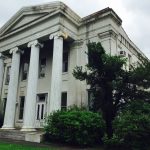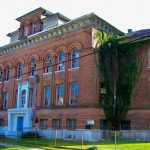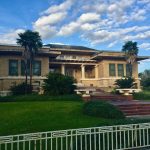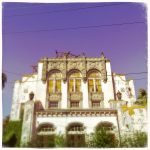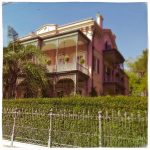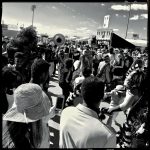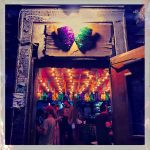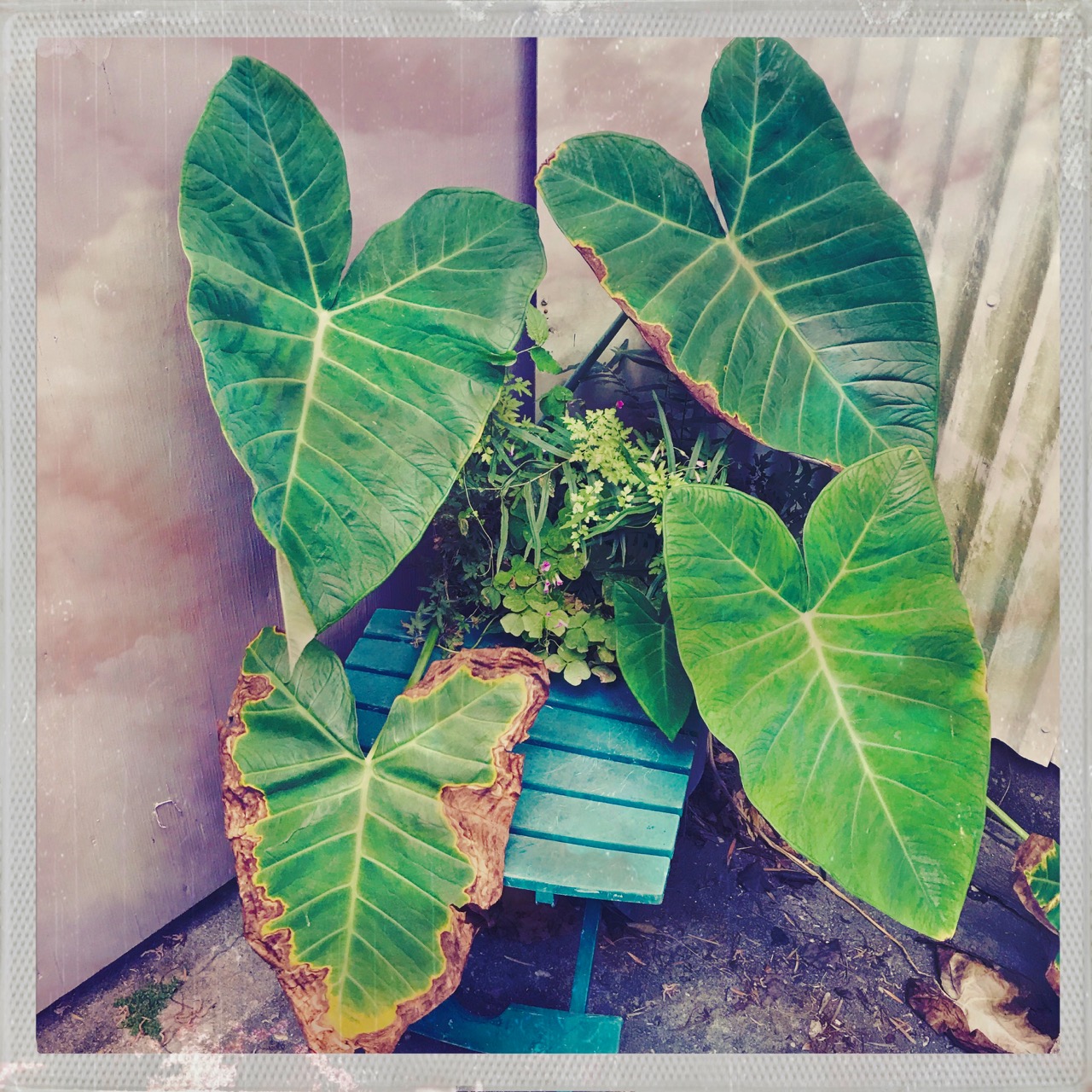
15 May New Orleans Report + Matador Playlist 5/11/17
Your Humble Narrator is returned, Gentle Reader(s), from a prolonged visitation to the town of his birth, New Orleans. It was a generally productive and quite enjoyable foray as it encompassed (largely coincidentally) both weekends of the New Orleans Jazz & Heritage Festival, referred to locally as ‘JazzFest,’ or simply ‘the Fest.’ The weather at this time of year can be highly variable in the Crescent City and I was treated to deluges of biblical proportions (accompanied by the inevitable minor flooding) as well as sunny, cool weather with minimal humidity. In New Orleans days such as the latter are to be savored and having such weather fall on the second weekend of JazzFest was a blessing in the double. Either way, I tried to make certain that my time was put to good use, indoor or out. Some of my outdoor time was spent reading the complete short stories of Truman Capote in the back yard of Inky South, next to the lovely elephant ear arrangement pictured above. A friendly lizard was resident amidst and amongst the foliage and he would watch me read and occasionally sing a lovely chirping lizardly song in the late afternoons. Quite blissful it was indeed.
Long bike rides are a frequent pastime during my New Orleans visits and in recent years I have been making great use of the paved walking/riding trail atop the levee, venturing out past the massive depression-era gothic arches of the Huey P. Long Bridge and as far upstream as Old Kenner. It’s good to know that, should the situation require it, I could ride my bike all the way to the Louis Armstrong Airport, less than a mile from the levee trail. In New Orleans you never know. The further upriver away from the city one goes the more wildlife one sees, ranging from a wide variety of water birds wading in the water along the batture (the river was quite high), raptors, turtles and, on one occasion, an alligator of substantial dimensions sunning itself in a shallow puddle under the watchful eye of a Levee Board police officer. Like all such bike rides, it is both the same day after day and always changing. The river traffic on one side, the city–Uptown New Orleans, Jefferson, Harrahan, Kenner, Destrehan and finally Norco–on the other. The trail comes to an end at the Bonnet Carre Spillway, some 27 miles northwest of the city.
On my two-wheeled way to and from the levee trail I typically wind a circuitous route through the 12th and 13th wards on my way to and through Audubon Park, avoiding the crowded primary arteries and sticking to the insanely potholed and patched side streets between Magazine and St. Charles. One of the great joys of New Orleans is its architectural diversity and I have herein recorded a few samples thereof. Or words to that effect. The stylistic range in Uptown where I reside, ride and pedest is wildly eclectic, from the lowdown and funky to the grand and stately with a smattering of bland post-war suburban-style bloopers tossed in amongst the decaying shotguns, modernist extravagances and huge rambling stucco or clapboard homes that are a staple of the city. Ink South, formerly the studio of my dear old dad, is a typical New Orleans double shotgun, its layout mirrored on either side of a lengthwise dividing wall, portions of which my dad had knocked out in the mid-’70s. Externally, it remains exactly as it had been when it was a two-family residence, owned and rented out by our neighborhood plumber, Mr. Mancuso (referred to by my brother and I when we were children as ‘Mr. Cuso-man’). It is my second home and I treasure it dearly.
Most homes in New Orleans tend to blend in with the typical muted palette of off-whites, grays and subtle pastels, but every now and then someone gets a bit more adventurous, like this nicely fading robin’s egg blue clapboard dwelling with nicely contrasting watermelon shutters. I love it.
Then, further Uptown at a prominent intersection just below Audubon Park there’s this insanely opulent post-modern Architectural Digest wet dream of a Dwell-ing. I’ve watched it come together over the past couple of years and ostentatious though it may be, I must admit it seems that they did a lovely job. We shall see whether it ages gracefully.
It’s right across the street from this characteristic quasi-Victorian three-story turreted home and the juxtaposition is, well, very New Orleans in its way. I have no idea what sort of building codes there are in Orleans Parish or in various neighborhoods (construction and demolition in the French Quarter being another matter entirely), but just about anything seems to go, even in the Garden District. In the inner portion of Santa Fe you can’t even dream about varying from the adobe-centric modes and codes without the Historical Commission Thought Police kicking in your door and slapping a red tag on yo ass.
My architectural explorations have, on occasion, taken me further uptown into the Riverbend neighborhood where all manner of interesting structures reside. One of the most prominent is the old Carrollton Courthouse building that was once home to YHN’s alma mater, Benjamin Franklin High School. Vacant and in a state of decay for several years now, it has apparently been sold by the city and is to become a private senior citizens center of some sort. This runs counter to a grassroots campaign to keep the building in public hands, but I guess there’s a victory of some sort to be found here as the stately edifice will not fall to the call of the wrecking ball.
A similar fate has befallen another of my alma maters—the former LaSalle Elementary School, later the first home of the celebrated New Orleans Center for Creative Arts (NOCCA). I attended the former between 1965 and ’70, and the latter in 1976 and ’77. NOCCA moved down to insanely opulent quarters in the Faubourg Marigny in 2000 and the school’s former digs on Perrier Street slowly went to seed. The 1901 building lives on—its stately facade now defaced by expanded balconies and diminished dormers—as home to luxury condos for well-heeled pensioners. Not optimal perhaps, but certainly preferable to the alternative. ‘Progress,’ I believe it’s called.
Further out Carrollton Avenue are a couple more favorites of mine. Frank Lloyd Wright never built anything in Louisiana but a student of his by the name of Edward F. Sporl was undoubtedly channeling his theatrically black-caped master when he designed this wonderful house at the corner of Freret and Short Streets for an executive of the United Fruit Company. Dating to 1917, it has the strong horizontal lines and geometric ornamentation (including the fence) that characterize the Prairie School. I have no idea who the current occupants may be but I trust they realize that their home is quite possibly unique in the city for its distinguished one-step-removed Wrightian pedigree.
Just a block away is this beautiful home, set back on a large lot at an angle to Carrollton Avenue. The Wilkinson Bruno home dates to 1850 and is an example of a rather idiosyncratic Gothic style—you don’t see many houses in which the facade is constructed at a 90-degree angle. This wonderfully fanciful structure was largely hidden from view by thick hedges when I was a kid but now it is now clearly visible from the sidewalk and from the streetcars passing by on the Carrollton Line. Remodeled in the late 1990’s, some excellent views of what you can’t see from the street are available via this link.
No architectural wandering through New Orleans is complete without a tour through the Garden District. On the upper edge of the GD, just off St. Charles Avenue on unassuming little Harmony Street, is this exotic Moorish baroque stucco fantasy, built in 1925. Reportedly one of the numerous homes of Jay Z and Beyoncé, this amazing structure, with it’s roof garden and massive interior spaces (26 foot ceilings!) was once home to a ballet school and a church. Like the other homes on this narrow block, the structure spans through to Seventh Street on the downtown side. Bordered closely on either side by the neighboring buildings, the house extends virtually to the edge of the sidewalk, front and back, leaving essentially no yard space at all—hence the expansive roof garden. The only sign of life I’ve ever seen here consists of a luxury black-out 4×4 occasionally idling in the short gated driveway, a liveried driver with a earpiece seated behind the wheel. Ah, how the other half lives!
A bit further on near the lower edge of the Garden District is this beauty—the 1869 Joseph Carrol house, certainly one of the handsomest mansions in the city. Everything in the balanced proportions of this fine home seems just right—from the wrought iron balconies with their lazily rotating fans, the generous lawn that wraps around the Chestnut Street side of the property, the picturesquely decaying carriage house on the river side of the lot. It’s all just… perfect. Anne Rice used to live directly across the street, and since her creation Lestat and his befanged posse went global that’s what most of the tourists have come to gawk at, but this house is a gem of the city. Legend has it that none other than Mark Twain was a habitué of this stately home back in the day.
But aside from meditative bicycle rides and architectural explorations, other things were afoot in the Crescent City. Mayor Mitch Landrieu’s initiative to remove the city’s most prominent monuments to the Confederacy was finally coming to a head and passions were heating up on both sides of the controversy. One thing that seems abundantly clear is that a significant majority of the pro-monument battle flag-waving agitators were from out-of-state, or at least out-of-city. New Orleans is now, and long has been, a majority African American city, politically liberal and Democratic-leaning, with a distinctly laissez-faire attitude regarding social mores. Regardless of which side of the argument you adhere to, the last thing New Orleanians need or care for is goddam carpetbaggers chugging into town in their hopped up coal-rollers, scaring the women and the horses and disrupting the languorous rhythms of daily life in the City That Forgot To Care. Don’t need it, don’t want it.
Perhaps you could scroll back to my posting in these pages from July 11, 2015, wherein I addressed the early salvos in the Confederate monuments debate (inspired by the AME Church massacre in South Carolina). For the time being, General Robert E. Lee remains atop his 90-foot plinth at the traffic circle that bears his name and General P.G.T. Beauregard is still astride his steed at the convergence of Esplanade, Carrolton Avenue, and Lelong Avenue. Things shifted into high gear on April 24 when the Battle of Liberty Place monument was removed under cover of night and with high security. The Liberty Place monument certainly represented the path of least resistance—the elongated white marble obelisk being the most obscure, most offensive, and least aesthetically compelling of the four target sculptures identified by the Landrieu administration for removal. The Jefferson Davis statue on its eponymous grassy parkway was removed just a couple of nights ago to much greater ruckus, but when the move is made on Generals Lee and Beauregard things could get really ugly.
The city has made it very clear that the monuments, not even the undistinguished Liberty Place obelisk, will be destroyed. Whether you love or hate what they represent, the Lee and especially the Beauregard monument, are beautifully executed examples of monumental 19th century public art and as aesthetic objects they deserve to be preserved. They will find other homes and, in fact, there already exists a fitting institution—the Confederate Memorial Hall Museum on Camp Street, just a block from Lee Circle. This institution, which dates to 1891, has somehow managed to remain isolated from the current brawl and I doubt whether the institution’s directors would want to engage the monument ruckus—at least not until tempers cool and the carpetbaggers are long gone. The Civil War Museum (as it is generally known) is not a large building by any means and it is situated in a tight clinch with the Ogden Museum of Southern Art and its associated library on either side. As a result the Civil War Museum has essentially zero outdoor space. Tis a pity, as it would be a perfect home for Lee, Beauregard, Davis, et al.
As mentioned previously, there were other games afoot in New Orleans in late April and early May and I was in attendance at the Fest in the company of the Commodore and Madame Commodore for the Friday 4/28 and 5/5 sessions. Session the first was overcast and muggy, and we spent a fair amount of time in the Blues Tent checking out Johnny Sansone’s excellent set (featuring a brief appearance by Susan Cowsill of Continental Drifters fame) followed by that of Mississippi’s own Mr. Sipp (Mississippi – Mr. Sipp. Get it?). The first Friday offerings are typically a bit on the lean side relative to our interests, fellow NOCCA alum Harry Connick, Jr., and Aaron Neville being the primary end-of-day headliners. NAS with the Soul Rebels were holding forth at the Congo Square Stage and, personally, I would have gone for that but the Commodore was having none of it and he was my ride. I was sorely tempted to bust a move on the Mavericks and Tom Petty on Sunday the 30th but the weather turned seriously nasty late Saturday. It poured all that night and through the early afternoon on Sunday, and I didn’t have no shrimp boots, me. The skies cleared in time for Raoul Malo, Tom Petty et al to do their thang and reliable reports reported reliably that their thang was highly satisfactory. Oh well…
We made a return the following Friday with nigh on perfect weather conditions and spent the day wandering hither and yon before closing out the afternoon with Wilco’s set at the Gentilly Stage. Wilco had been at the Fest a couple of years previous but their set was cut short by inclement weather. Jeff Tweedy & Co. seemed to determined to make up for it this time around and they laid down an excellent and diverse set, covering the width and breadth of the Wilco discography. The sound was top notch and Nels Cline was in fine full-shred form. Reuniting with the Commodore I proclaimed ‘Now THAT is what a rock n’ roll band is supposed to sound like!’ The sentiment was unanimous. So it is written, so shall it be done.
Swedish-born/New Orleans-based Anders Osborne and his band had preceded Wilco on the Gentilly Stage and the lead guitarist/mandolinist with the group was former Albuquerque homeboy Eric McFadden. I remember McFadden well from his scuffling teenage days hanging around Budget Tapes & Records on Central Avenue, driving the Goof and I nuts. The kid has come a long, long way since the early ’80s, having gone on to play with a pretty stellar and diverse list of rockers, funkers and funk-rockers. I caught up with him for a brief reunion in the CD tent where he was signing discs with Osborne. It felt like Osborne had been keeping Eric somewhat reigned in during their set, apparently because the boss has the notion of pitching himself as the primary guitarist in the group—a notion that I would hope he might disabuse himself of the not-too-distant future.
Anther highlight of the week betwixt and between Fest weekends was checking out Brother Sonny and Brother Tony’s band, the Fortifiers, at Vaughan’s, deep—and I do mean deep—in the Bywater. Miss the turn off of St. Claude at France Street and you be headed cross the bridge into the Lower 9 afore you know it. Vaughan’s had quite the scene goin on and the crowd (some of whom, Brother Tony included, had just come from seeing Neil Diamond over at the Smoothie King Center) was in an appropriately festive JazzFest mood. I had to leave early as I was driving cross the lake to Mandeville in the morning, but I believe it can be said with a fair degree of certainty that a good time was had by one and all. As I walked out the door all available evidence seemed to be pointing in that direction.
Well, Gentle Reader(s), that’s about it for my New Orleans report. After two weeks in residence at Ink South I headed home in the new sled and, darn the luck, Texas was still there, inserting itself rather assertively to impede my northwesterly progress once again. It’s an annoyance but what’s to be done? Loading the Inkmobile on a ship and sailing through the Panama Canal was one option but my budget didn’t allow for it. The northern route through Oklahoma isn’t much of an alternative and if there’s any state that’s redder than Texas it’s Oklahoma, hence the Lone Star road once again.
Oh, and here’s a Matador Playlist for you. I missed out on the grand Matador 10th Anniversary gala on May 4, but despite being the bar’s longest serving DJ I don’t think my absence was the cause of any significant concern. I’ll try a bit harder to make the gig in 2027.
Grammar of Life – Charles Bukowski
Saturday Night Fish Fry, Pts. 1 & 2 – Louis Jordan and his Tympani Five
We’re Desperate – X
Tangerine – Led Zeppelin
Dandy – the Kinks
Jump They Say – David Bowie
Spooky Action At A Distance – Sqürl
Steel and Blood – Minus the Bear
Brother John – the Wild Tchoupitoulas
Big-Jesus-Trash-Can – the Birthday Party
Jealous Again – Black Flag
Falling Down – Oasis
Dirty Deeds Done Dirt Cheap – AC/DC
What’s New Pussycat? – Tom Jones
Can’t Hold On – Black Lips
Screwdriver – Prince
Come Around – Doctor Bison
Wichita Lineman – Glen Campbell
Back On the Chain Gang – the Pretenders
Cinco de Mayo – Reverend Horton Heat
Change the Locks – Lucinda Williams
Rock Star – Agnostic Front
Do the Strand – Roxy Music
In 3’s – the Beastie Boys
Five Foot One – Iggy Pop
Season of the Witch – Donovan
Heart Like A Wheel – Human League
Worm Tamer – Grinderman
Help I’m Alive – Metric
Here Comes My Girl – Tom Petty & the Heartbreakers
The Boss – James Brown
(The Angels Wanna Wear My) Red Shoes – Elvis Costello & the Attractions
Breakdown – Buzzcocks
Blue Monday – New Order
Ashes to Ashes – David Bowie
Dance the Night Away – Van Halen
Emotional Rescue – The Rolling Stones
Crying – Roy Orbison
I Fink U Freeky – Die Antwoord
Piece of My Heart – Janis Joplin
Roadhouse Blues – the Doors
Fire of Love – the Gun Club
Goo Goo Muck – the Cramps
Tales of Brave Ulysses – Cream
The Mad Daddy – the Cramps
People Say – the Meters
Rudie Can’t Fail – the Clash
Freddie’s Dead – Curtis Mayfield
Thursday – Morphine
Shake Some Action – the Flamin Groovies
Can’t Hardly Wait – the Replacements
I Don’t Wanna – the Von Bondies
Nobody Really Cares If You Don’t Go to the Party – Courtney Barnett
Bankrobber – the Clash
King’s Lead Hat – Brian Eno
The Blood Is Love – Queens of the Stone Age
Natalia’s Song – Zomby & ReARK
Homicide – 999
For Your Life – Led Zeppelin
Away From the Numbers – the Jam
Search and Destroy – Iggy & the Stooges
Hey, Good Lookin’ – Hank Williams
George Jones Talkin’ Cell Phone Blues – Drive-By Truckers
Salad Days – Minor Threat
I Want You To Know – Dinosaur Jr.
Hairdresser On Fire – Morrissey
How Soon Is Now – the Smiths
Enough to Get to Shore – Clark Vreeland
The Grim Reaper – the Milkshakes
Spill the Wine – Eric Burdon & War
The Most Beautiful Girl – Charlie Rich
Waterloo Sunset – the Kinks
Gonna Rock n’ Roll Tonight – Carl Mann
Pedestrian at Best – Courtney Barnett
Wild is the Wind – David Bowie
I Say A Little Prayer – Aretha Franklin
World Without Tears – Lucinda Williams
Buona Sera – Louis Prima
Happy Trails – Roy Rogers & Dale Evans (feat. Trigger on Gingko Bilobaphone)
Taxi – Bryan Ferry

